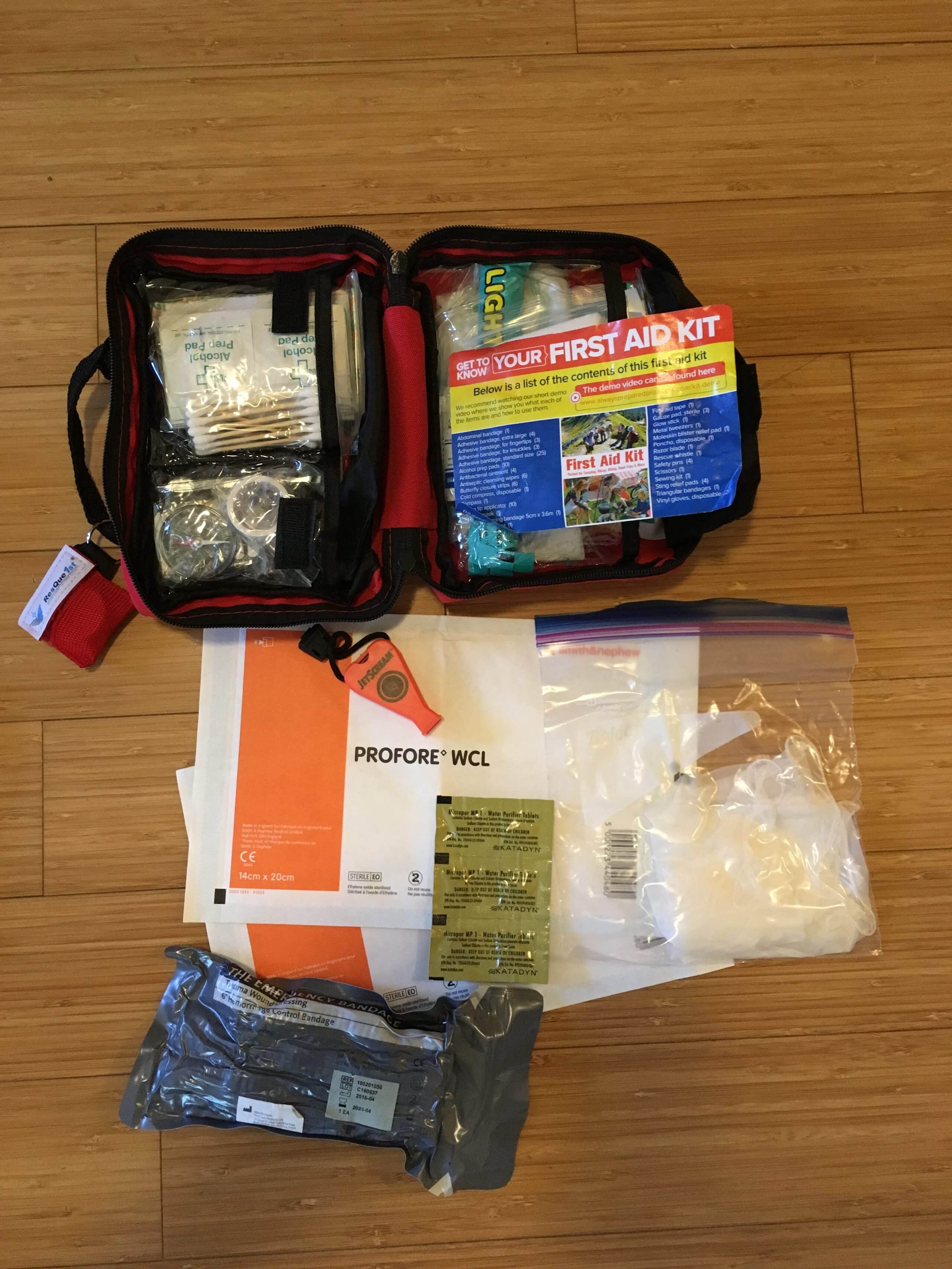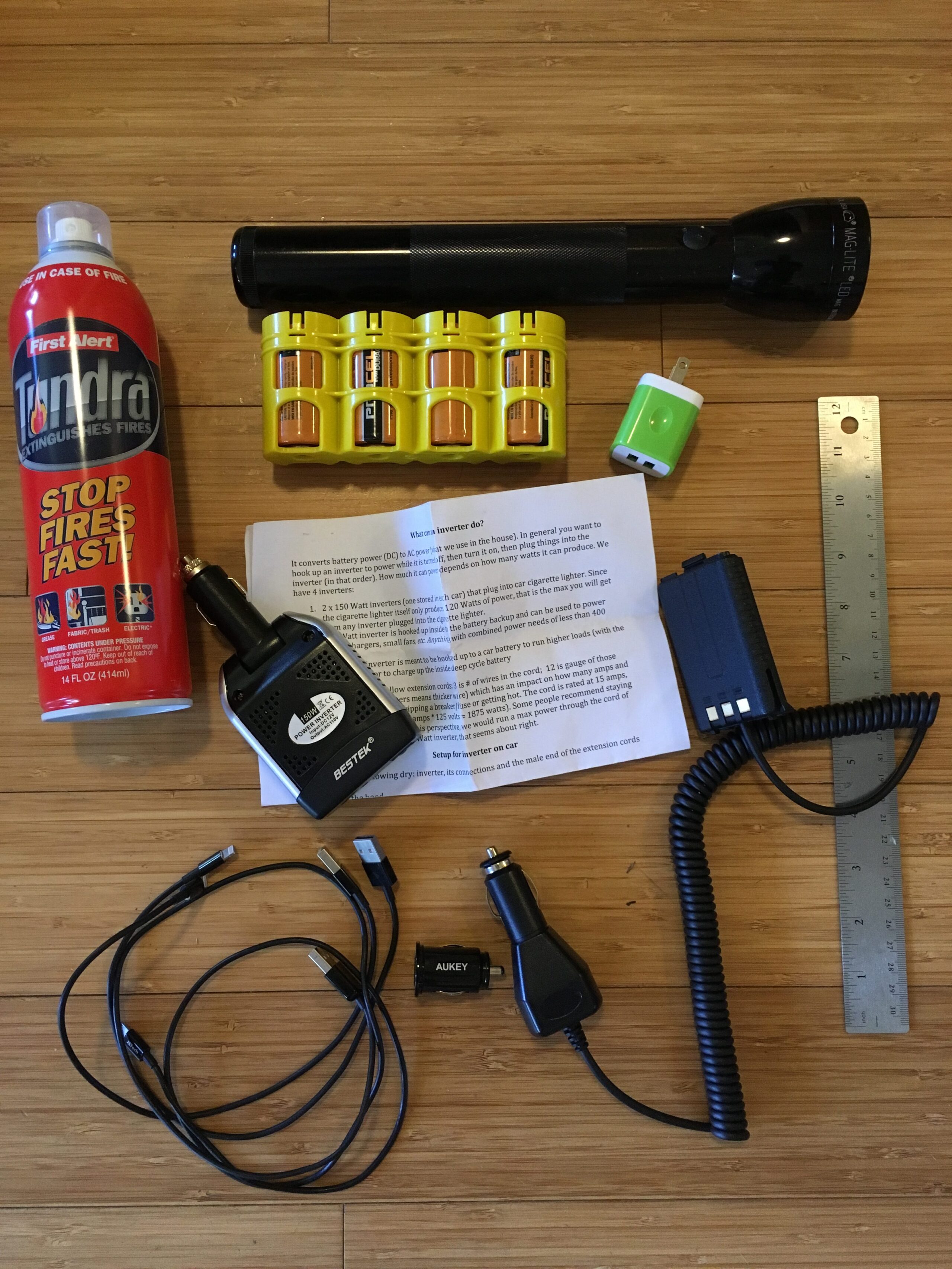Emergency Car Kit
See parent article on prepping priorities.
The Emergency Car Kit consists of everything in the picture above (stored in a duffle bag in the trunk) and some items stored inside the car (pictured below). You could, of course, just buy a kit from AAA, but as with anything, you get what you pay for. I’m not knocking the AAA and other off-the-shelf kits, I don’t own them. Please comment if you do. Ideally, the Emergency Car Kit would form an integrated supplement to your 72-hour disaster kit (all the car-related items in one kit, all the human survival related items in another), itself a portable solution for many of the 9 priorities covered in the parent article.
The 12-inch ruler to the right-hand side of the above picture is there to size items. The Everest 20-inch round duffle ($16) is a good quality bad and is a good size for the following items:
- Heavy duty jumper cables (20′ of 4 gauge runs about $19)
- Fix-A-Flat Aerosol Tire Inflator ($10). I’m not sure if this works reliably in cold temperatures.
- Hand Crank Self Powered AM/FM NOAA Solar Weather Radio ($55)
- Orion emergency road flares ($23 with shipping). If you get this, you do not need an additional reflective vest as the kit comes with one.
- State map book (Wisconsin example, $14)
- First aid kit ($20). I have supplemented this particular first aid kit with the
 items pictured below the kit. They include water purification tablets, rubber gloves, a better emergency whistle ($6.50), an Israeli style bandage ($9), and sterile bandages designed to be put directly on wounds. Hooked to the carry strap is a better CPR mask ($2-3 each but came in a 5-pack for $12).
items pictured below the kit. They include water purification tablets, rubber gloves, a better emergency whistle ($6.50), an Israeli style bandage ($9), and sterile bandages designed to be put directly on wounds. Hooked to the carry strap is a better CPR mask ($2-3 each but came in a 5-pack for $12). - Reflective vest ($7)
- Bungee cords
- Caution tape ($7 – length purchased split up and used in 2 cars)
- Tow strap ($10). I’d rather have one of these that has a ratchet and doubles as a strap for securing items to the roof, but at the time, I didn’t think of this.
- Duct Tape ($13)
- Emergency candle ($6, in glove compartment)
- Winter gloves (can double as work gloves)
- All of the stuff along the right-hand side of the picture fits into a zip-lock bag and consists of:
- 4 x Hot pocket warmers ($1 each, $25 for 40 pack)
- Emergency food. These taste kind of like pasty sugar, but are designed for 5 years shelf-life and the calories you need in an emergency.
- 1 x 16 ounce, 2400 calorie Mainstay Emergency Food Rations ($11, $34 for 3 pack)
- 2 x New Millennium Energy Bars ($1.50 each, 12-pack for $18) each with 4,000 calories. They come in flavors. None of them are something you’d really want to eat in a non-emergency, but that’s not what they’re for.
- 1 x 16 ounce, 2400 calorie Mainstay Emergency Food Rations ($11, $34 for 3 pack)
- 50′ of paracord ($3, 200 feet for $10)
- A small utility tool
- Screwdriver with multiple tips
- Garbage bags
- Cable ties
- Crescent wrench
- Pliars
- Collapsable funnel ($6)
- Water (not shown)
- Other possible tools (not shown): Vise grips, A tire pressure gauge, Some rags
- Small air compressor for filling up tires ($40; not shown)
- Tire fix kit ($8, not shown)
- Car fluids (not shown): Two quarts of oil, One gallon of antifreeze, Brake fluid, A spray bottle with washer fluid
- 4 x Hot pocket warmers ($1 each, $25 for 40 pack)
Also in the trunk is a sleeping bag. I used to have water back there in the collapsable water bags featured in this article but had problems with condensation making everything wet. Another item that would probably be good is one or more gasoline cans. There is a collapsable version of these available, designed for one-time use only.
In addition to the items that live in the duffle bag in the back of the trunk, the items pictured above are stored inside the car. Other than the fire extinguisher, all of these items are part of the emergency power and emergency communications plans.
- Tundra fire extinguisher ($11, comes in two-pack for $22). Hint: Draw an arrow on the top of the white dispenser with a black sharpie to indicate the outlet — in an emergency, you don’t want to fire the wrong direction.
- 3, D-cell Mag flashlight with extra Duracell batteries stored in yellow caddie
- A USB AC phone charger with 2.1 amp x 2 capacity ($4, comes in pack of 3 for $11)
- Instructions for using inverters (see emergency power article) and family emergency phone numbers and contact plan (see emergency communications article)
- A 150-watt cigarette lighter inverter ($18). Note: cigarette lighters typically produce 120 Watts of power so your 150-Watt inverter will obviously only throughput 120 Watts. See emergency communications article for more details and how this and the car is part of a larger emergency power plan.
- 2 x 1 foot USB-iphone charging cables ($4). 5-pack is $10 so cost is about $2 each.
- 1 x 3 foot USB-iphone charging cable ($8)
- 1 x Aukey USB cigarette lighter charger with 2 x 2.4 amp outputs ($10)
- Baofeng Radio cigarette lighter charger ($15). See emergency communications article for more details.
Save
Save
Save
Save
Save
Save
Save
Save
Save
Save
Save
Save
Save
Save
Save
Save
Save

Pingback: Short-term resilience: Prepping for Disasters – 9 Priorities | One Planet Thriving